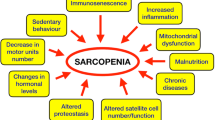Summary
Male NMRI-mice were subjected to exhaustive treadmill exercise. 3 and 6 days after the exertion, quadriceps femoris muscles were examined histologically and analyzed for acid hydrolases in order to follow the degree and progress of injuries. Prednisolone (PRED), an anti-inflammatory corticosteroid, was given to some of the animals in order to modify the exercise response. The PRED administration began 14 h before exercise and continued until the end of the experiment (6 days). The doses were 25 and 50 mg·kg−1 i.p. twice a day. The activities of both arylsulphatase andΒ-glucuronidase increased significantly in the exercise control group after 3 and 6 days. The increase in activity correlated with fibre necrosis and an abundant infiltration of inflammatory cells, and was greatest after 3 days. After 6 days the inflammatory response decreased and regenerating muscle fibres were seen. PRED decreased the exercise-induced acid hydrolase response. The decrease was most prominent after 3 days with PRED 50 mg·kg−1·day−1. PRED also diminished degeneration and inflammation. The results suggest that the decrease in acid hydrolase activities was due to a lesser infiltration of inflammatory cells to the injured area.
Similar content being viewed by others
References
Barrett AJ (1972) Lysosomal enzymes. In: Dingle JT (ed) Lysosomes, a laboratory handbook. Elsevier/North-Holland, Amsterdam, pp 46–126
Dannenberg AM (1979) The anti-inflammatory effects of glucocorticosteroids. A brief review of the literature. Inflammation 3: 329–343
Decker RS, Wildenthal K (1978) Influence of methylprednisolone on ultrastructural and cytochemical changes during myocardial ischaemia. Am J Pathol 92: 1–22
Galvin MJ, Lefer AM (1979) Prevention of hypoxia-induced liver damage by three-day glucocorticoid administration. J Reticuloendothel Soc 25: 61–72
Ghussen F, Stock W, Bongartz R (1979) Die Wirkung von Methylprednisolon auf den Verlauf des experimentellen Tourniquet-Schock des Hundes. Res Exp Med [Berl] 176: 87–95
Glenn TM, Lefer AM (1970) Role of lysosomes in the pathogenesis of splanchnic ischemia shock in cats. Circ Res 27: 783–797
Hargens AR, Akeson WH, Mubarak SJ, Owen CA, Evans KL, Garetto LP, Gonsalves MR, Schmidt DA (1978) Fluid balance within the canine anterolateral compartment and its relationship to compartment syndromes. J Bone Joint Surg 60A: 499–505
Loegering DJ, Bonin ML, Smith JJ (1975) Effects of exercise, hypoxia, and epinephrine on lysosomes and plasma enzymes. Exp Mol Pathol 22: 242–251
Lowry OH, Rosebrough NJ, Farr AL, Randall RJ (1951) Protein measurement with the Folin phenol reagent. J Biol Chem 193: 265–275
Masters TN, Harbold NB, Hall DG, Jackson RD, Mullers DC, Daugherty HK, Robicsek K (1976) Beneficial metabolic effects of methylprednisolone sodium succinate in acute myocardial ischemia. Am J Cardiol 37: 577–663
Matsen FA III (1980) Compartmental syndromes. Hosp Pract 15: 113–117
McGrath JA, Goldspink DF (1982) Glucocorticoid action on protein synthesis and protein breakdown in isolated skeletal muscles. Biochem J 206: 641–645
Rubanyi G, Satori ö, Balogh I, Bakos M, Kovach AGB (1981) Protection of functional and structural integrity of the rat myocardium by dexamethasone in hemorrhagic shock. Circ Schock 8: 491–501
Salminen A, Vihko V (1983) Susceptibility of mouse skeletal muscles to exercise injuries. Muscle Nerve 6: 596–601
Salminen A, Vihko V (1984) Autophagic response to strenuous exercise in mouse skeletal muscle fibers. Virchows Arch [Cell Pathol] 45: 97–106
Schumann HJ (1972) überlastungsnekrosen der Skelettmuskulatur nach experimentellem Laufzwang. Zentralbl Allg Pathol 116: 181–190
Simons DG (1975) Special review. Muscle pain syndromes — Part I. Am J Phys Med 54: 289–311
Simons DG (1976) Special review. Muscle pain syndromes — Part II. Am J Phys Med 55: 15–42
Spath J, Lane DL, Lefer AM (1974) Protective action of methylprednisolone on the myocardium during experimental myocardial ischemia in the cat. Circ Res 35: 44–51
Tomas FM, Munro HN, Young VR (1979) Effect of glucocorticoid administration on the rate of muscle protein breakdown in vivo in rats, as measured by urinary excretion of N-methylhistidine. Biochem J 178: 139–146
Vihko V, RantamÄki J, Salminen A (1978a) Exhaustive physical exercise and acid hydrolase activity in mouse skeletal muscle. A histochemical study. Histochemistry 57: 237–249
Vihko V, Salminen A, RantamÄki J (1978b) Acid hydrolase activity in red and white skeletal muscle of mice during a two-week period following exhausting exercise. Pflügers Arch 378: 99–106
Wagner JA, Critz JB (1968) The effect of prednisolone on the serum creatine phosphokinase response to exercise. Exp Biol Med 128: 716–720
Author information
Authors and Affiliations
Additional information
This study was supported by the Academy of Finland and the Research Council for Physical Education and Sport (Ministry of Education, Finland)
Rights and permissions
About this article
Cite this article
Kihlström, M., Salminen, A. & Vihko, V. Prednisolone decreases exercise-induced acid hydrolase response in mouse skeletal muscle. Europ. J. Appl. Physiol. 53, 53–56 (1984). https://doi.org/10.1007/BF00964690
Accepted:
Issue Date:
DOI: https://doi.org/10.1007/BF00964690




